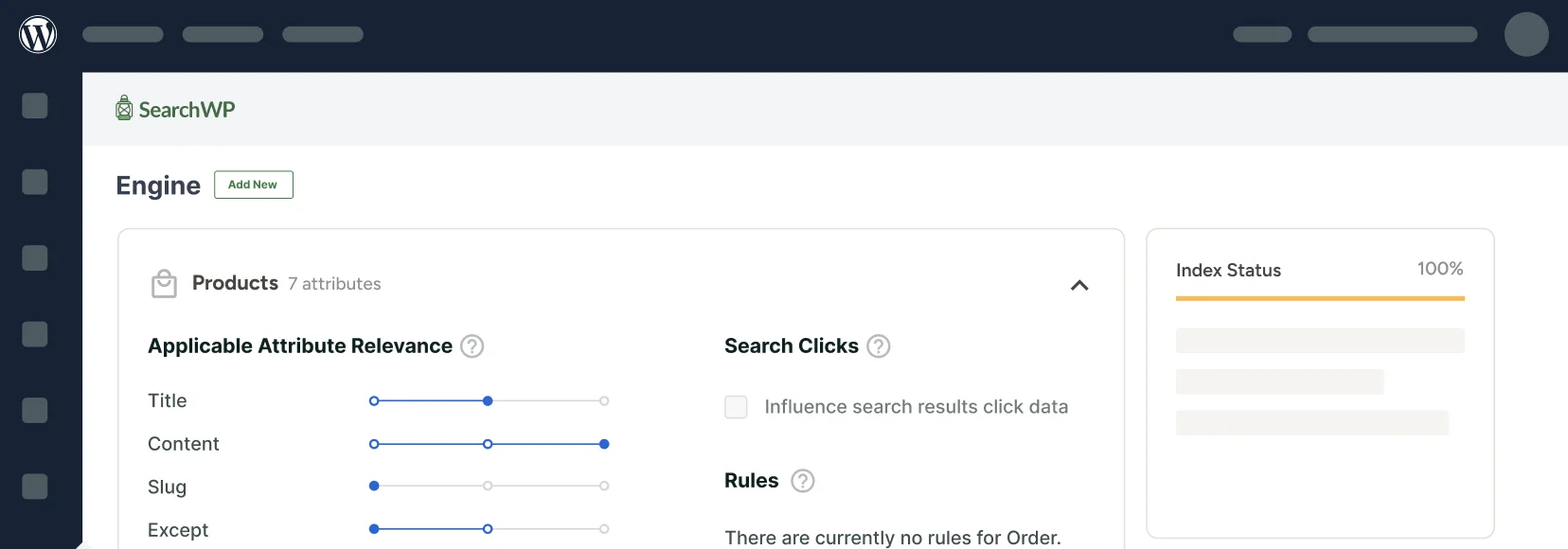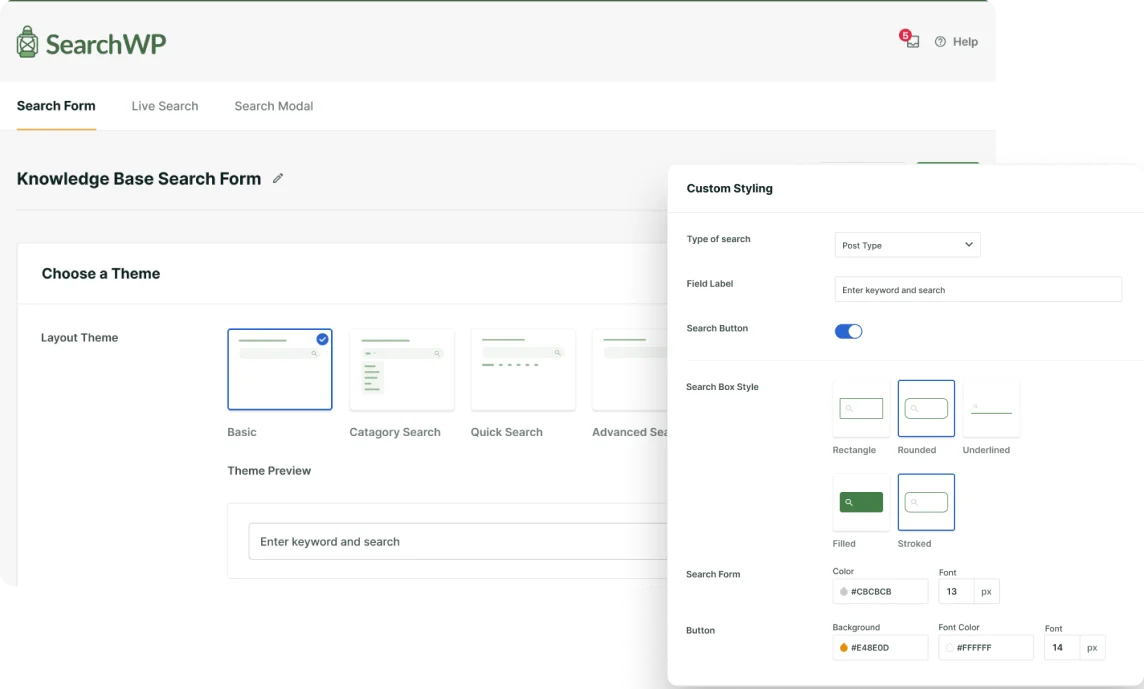
Imagine knowing exactly what your audience is looking for when they land on your page.
This is where tracking what visitors search for on your WordPress site comes in handy.
Tracking data removes guesswork and provides actionable information that can transform your website from good to great.
Why is this so important? Because your site search bar is a goldmine of information revealing user intent. Understanding these search queries allows you to fine-tune your content strategy, improve site navigation, and ultimately give your visitors exactly what they want.
In this article, we’ll show how to track your WordPress site search activity.
Why Track Searches on Your Site?
If you want to ensure the best user experience for your site visitors, then it’s crucial to examine their needs.
One of the best ways to do this is by start collecting data about searches users make on your site.
Analyzing the visitors’ search behavior lets you know the way they search and what they’re looking for.
That’s precious information that you can use in different cases:
- Get New Content Ideas: Gathered search data is a great source of fresh content ideas. Analyze it to get in touch with your audience and provide them with the content they want.
- Figure Out What’s Missing From Your Site: See a lot of search queries related to a certain topic but don’t have content dedicated to it? It’s a missed opportunity to get more traffic.
- Restructure and Update Your Content: Search data tracking allows you to take a look at your site content from a different angle and restructure it if needed.
- Get to Know Your Audience Better: There are not so many opportunities for website owners to get in touch with their audience. Tracking on-site searches is one of the best ways to better understand your audience’s needs.
Now let’s see how you can start collecting data about search activity on your WordPress site. We’ll cover 2 methods in this guide, which includes using SearchWP and MonsterInsights. You can click the links below to jump ahead to your preferred method.
Method 1: Track Site Searches Using SearchWP
The easiest way to track searches on your WordPress site is to use SearchWP.
As the best WordPress search plugin, it drastically expands the capabilities of the native WordPress search engine and helps users find what they’re looking for.

Here are just some of the useful things you can do with SearchWP:
- Searchable Custom Fields: The default WordPress search engine doesn’t consider data inside the custom fields, but with SearchWP, you can make custom fields searchable.
- PDF and Document Indexing: The native WordPress search engine completely ignores the text inside PDFs and other uploaded documents. With SearchWP, you can include documents into the search results in just a few clicks.
- Live Search Results: SearchWP comes with plenty of useful extensions, including Live Search. It eases your website navigation and ensures a better user experience for your visitors.
- Automatic Theme Integration: You don’t have to take any additional steps after installing SearchWP, as it integrates with your current site search form and search results template.
You can start by visiting the SearchWP website and signing up for a new account.
When you’re done, simply go to the ‘Downloads’ tab in your SearchWP account and click Download SearchWP to save the plugin to your computer.

Next, you will need to log into your WordPress admin area and upload SearchWP to your site.
Need help with that? Kindly check out this step-by-step guide on how to install a WordPress plugin.
After that, you will see the SearchWP welcome screen and setup wizard. Go ahead and click the ‘Start Onboarding Wizard’ button and follow the onscreen instructions.
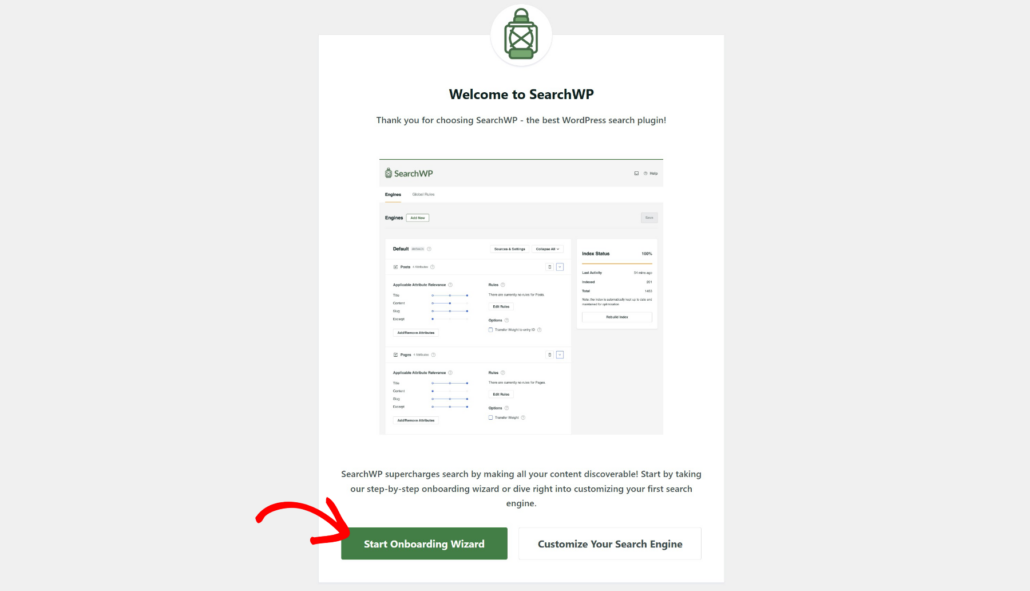
Even though SearchWP gathers search data by default, using the Metrics extension lets you get advanced information about your users’ search behavior.
Simply head to SearchWP » Extensions from the WordPress dashboard and navigate to the ‘Metrics’ extension. From here, you can click the Install button.
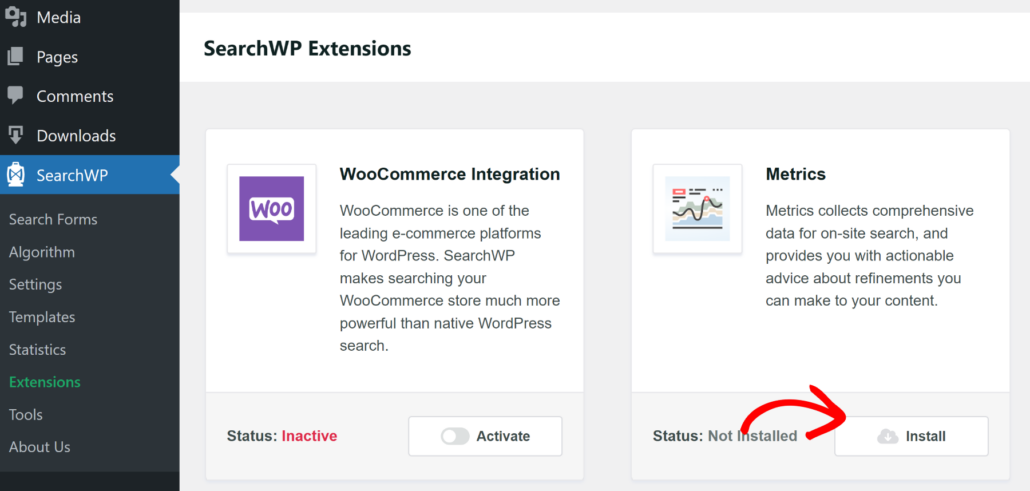
Once the extension is active, you can head to SearchWP » Metrics from your WordPress dashboard.
On this tab, you can find all the data about searches made by your visitors.
There will be no data initially because you just installed the plugin. But starting today, all searches made on your site will appear here.
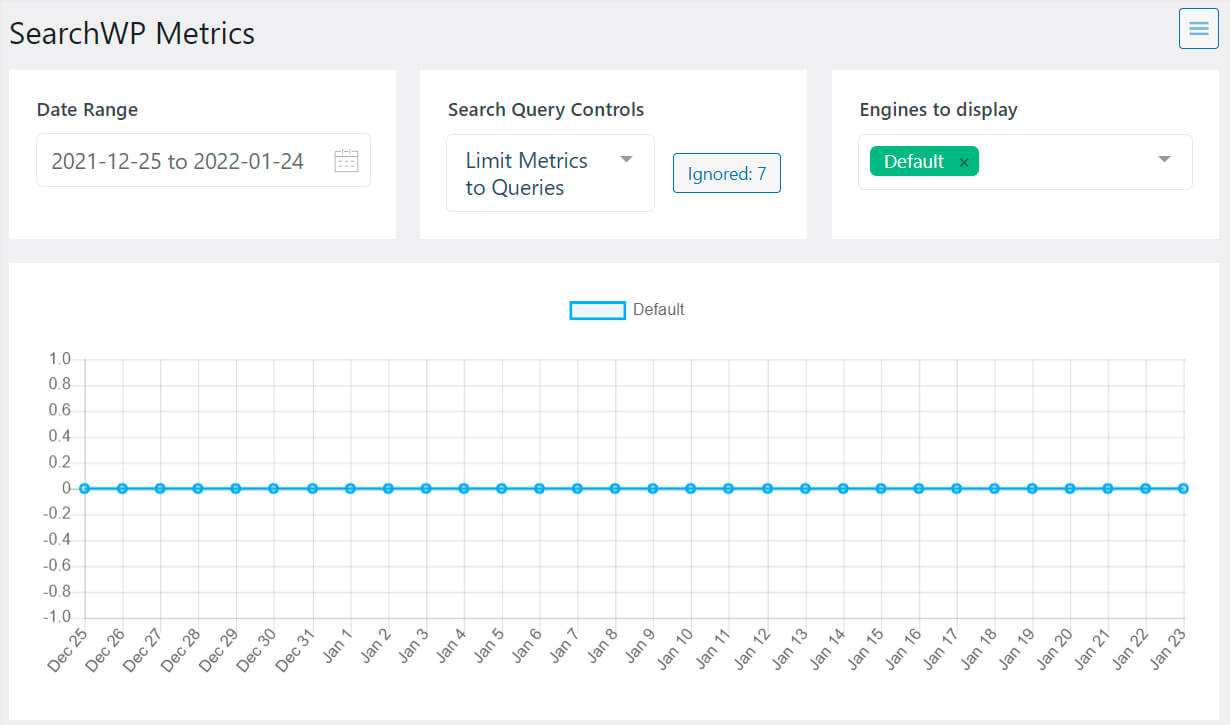
SearchWP’s Metrics extension collects comprehensive data for on-site search, and provides you with actionable advice about changes you can make to your content as time goes on.
Once you start collecting search data, you will see different statistics like total searches, clicks per search, and popular searches.
The best part is that SearchWP also shows actionable insights, which can help you grow your business. For example, it will highlight queries with high conversion rate, so you can optimize them across your site.
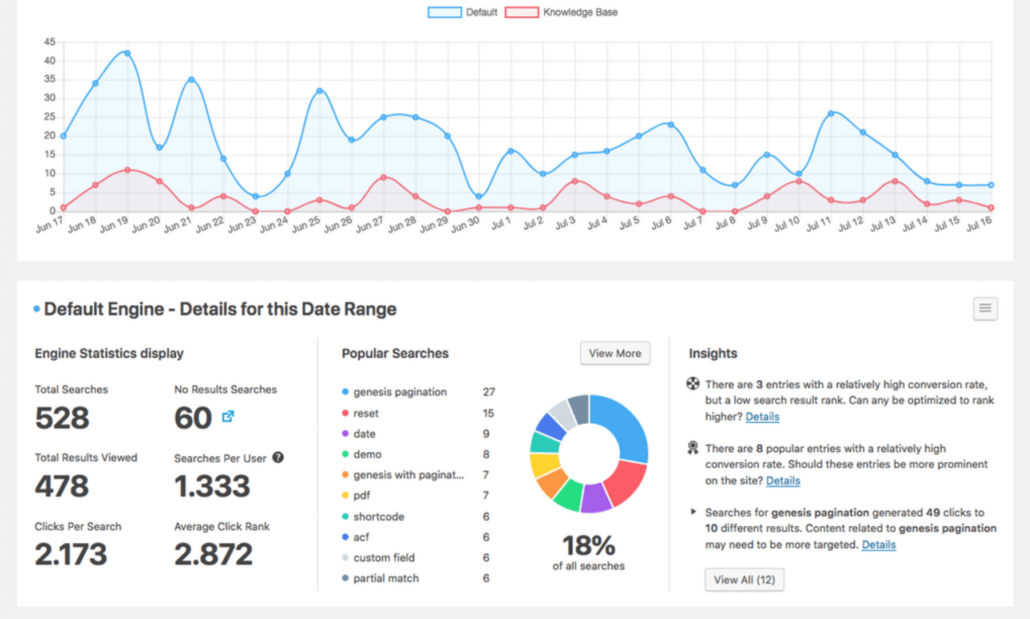
Method 2: Track WordPress Searches Using MonsterInsights
You can also track searches on your WordPress site in Google Analytics using MonsterInsights.
It is the best analytics plugin for WordPress and helps you set up tracking in Google Analytics without editing code.

Normally, you can track searches by connecting Google Analytics to your site. But it’s tricky to do for beginners since it requires making changes to the theme code.
MonsteInsights allows you to connect your site with Google Analytics in just a couple of clicks.
Besides, you also get reports inside the WordPress dashboard, real-time analytics, eCommerce tracking, site speed report, and much more.
The best part is that you can get started with the MonsterInsights Lite version for free. It will help you set up Google Analytics in just a few clicks.
First, you will need to go to Plugins » Add new from your WordPress dashboard and search for MonsterInsights.
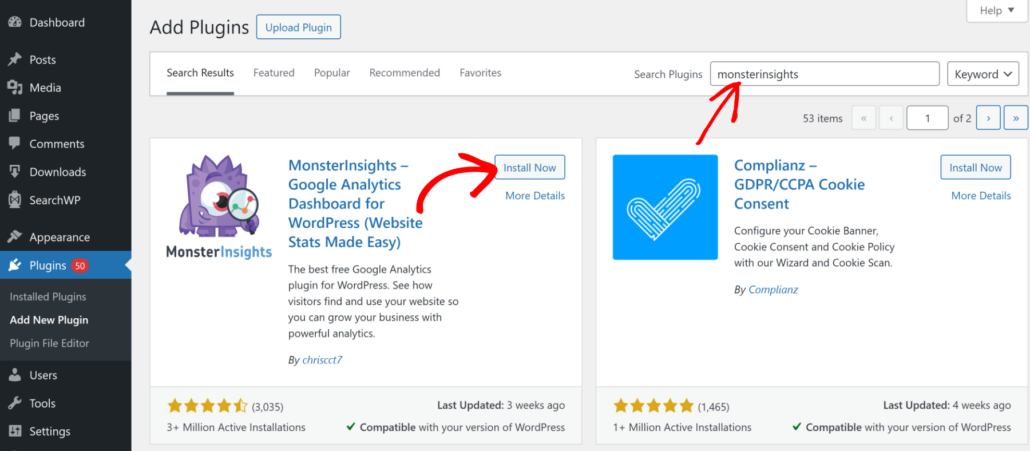
From here, you will need to install and activate the MonsterInsights plugin. If you need help with this, then please see the guide on how to install a WordPress plugin.
Upon activation, you’ll see the MonsterInsights setup wizard. Simply click the ‘Launch the Wizard’ button and follow the onscreen instructions to connect your site with Google Analytics.

You may want to see this guide on how to install Google Analytics in WordPress for complete step-by-step instructions.
After successfully integrating Google Analytics with your WordPress site, the next step is to activate site search tracking.
Simply begin by logging into your Google Analytics account and selecting the relevant site for search tracking activation.
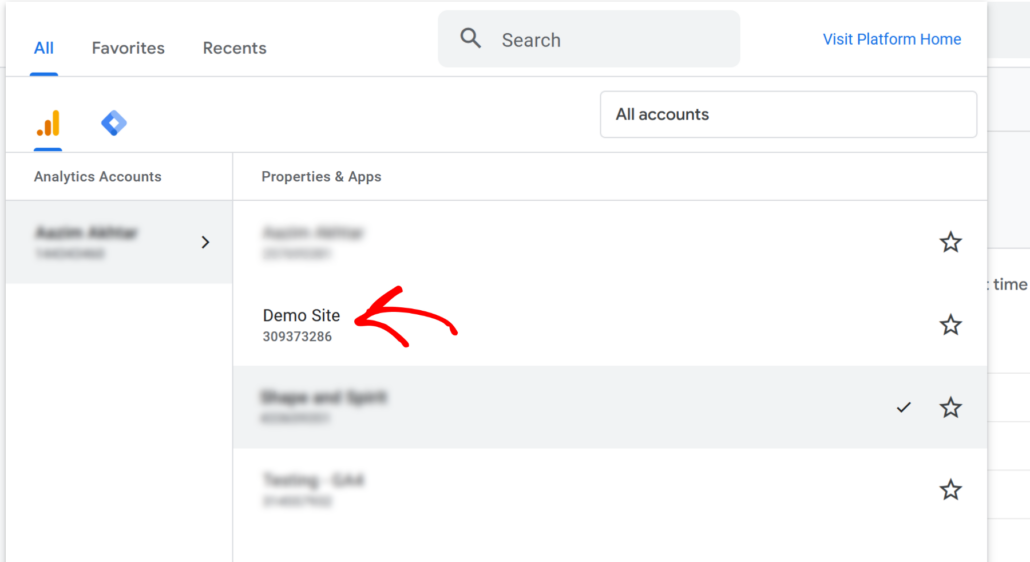
After that, you will need to click Admin cog icon in the bottom left corner.
Next, you can click the ‘Data streams’ option under Data collection and modification.
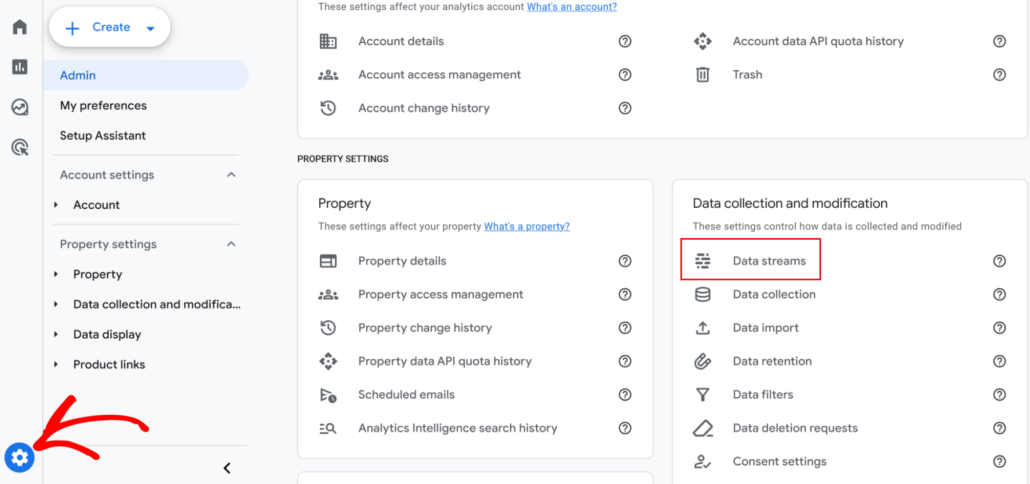
Here, you will see all your data streams in Google Analytics.
Go ahead and select the active stream.

After that, you’ll need to ensure that the ‘Enhanced measurement’ option is enabled. If it is not, then simply click the toggle to enable it.
From here, you can click the settings cog icon to configure Enhanced measurement options.
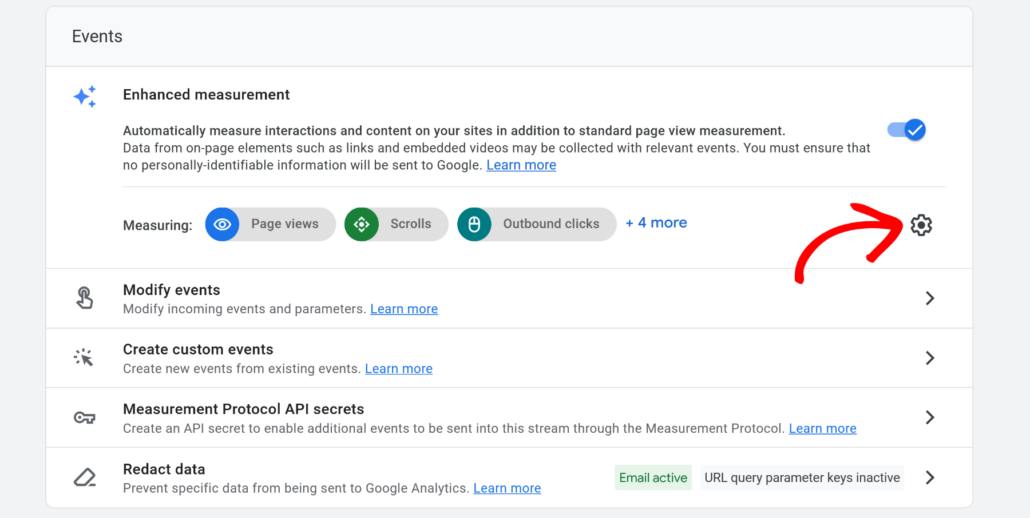
Next, you will need to check if Site search tracking is enabled or not.
You can simply click the toggle to enable it in Google Analytics.

Google Analytics will now start tracking site searches on your website.
The next step is to view the report in Google Analytics. To start, open the Explore tab and create a Blank report.
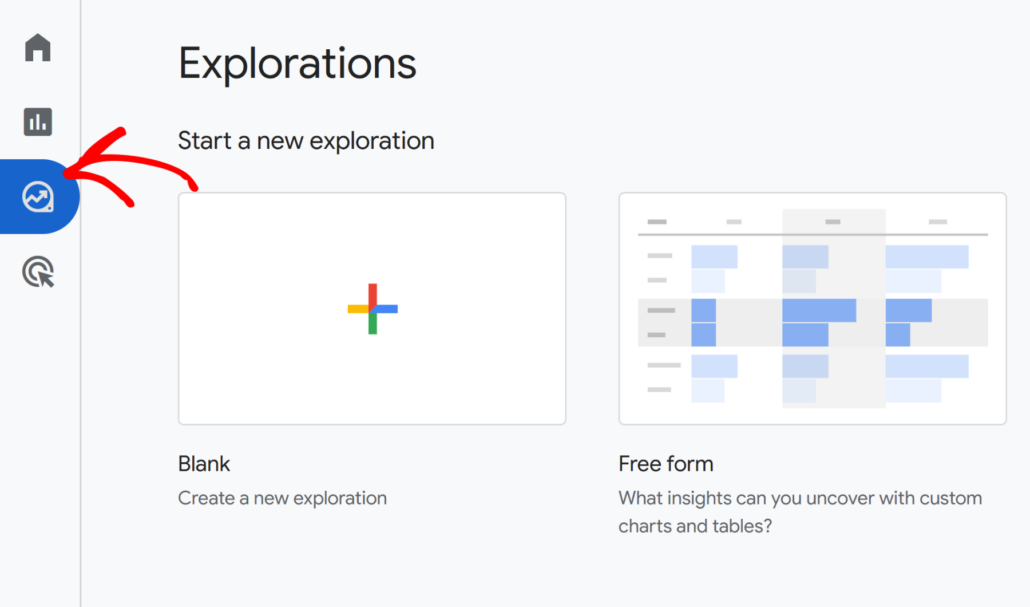
After that, you will need to select variables for your report.
First, click the + sign in the Dimensions section.
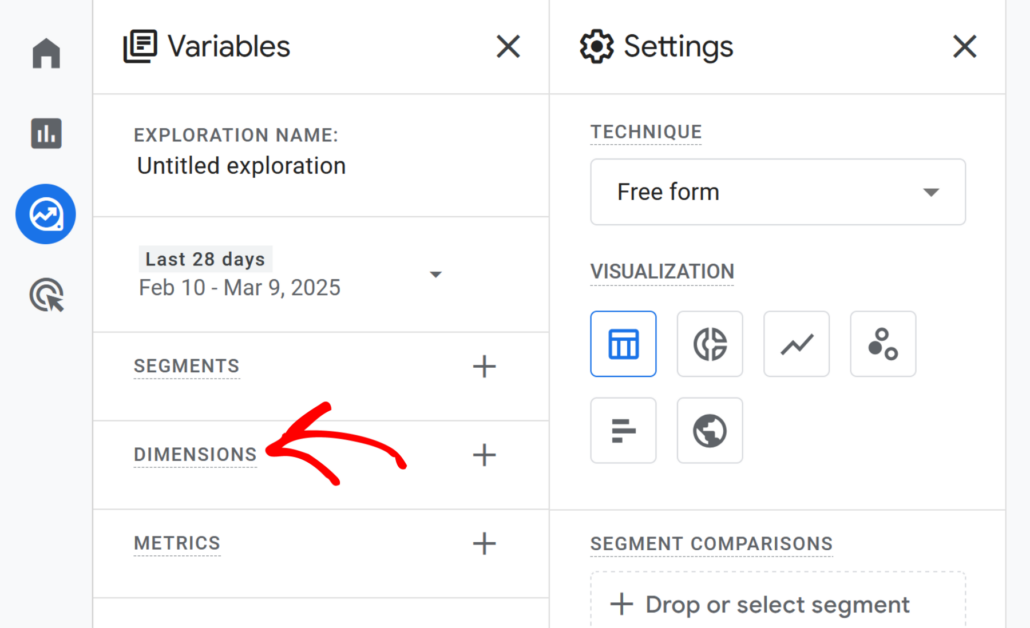
Next, you will need to select Search term and Event name as the Dimensions.
You can use the search bar at the top to find these Dimensions.
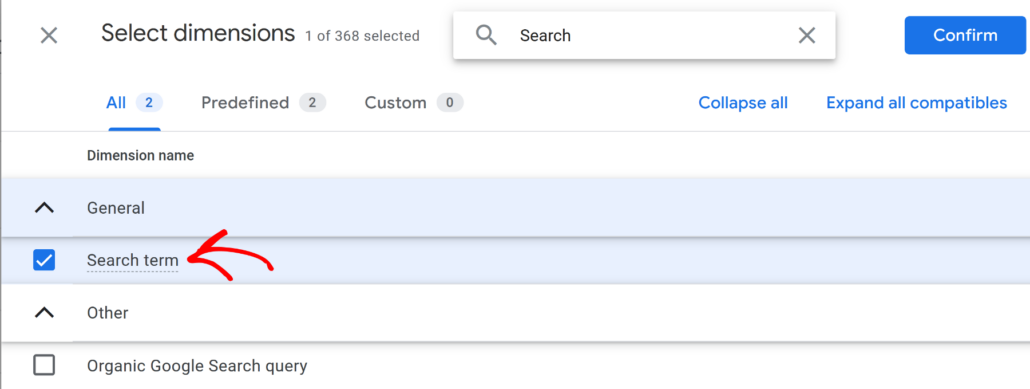
When you’re done, simply click the Confirm button.
After that, you will need to choose Metrics for your report. Simply click the + icon to select metrics for your report.
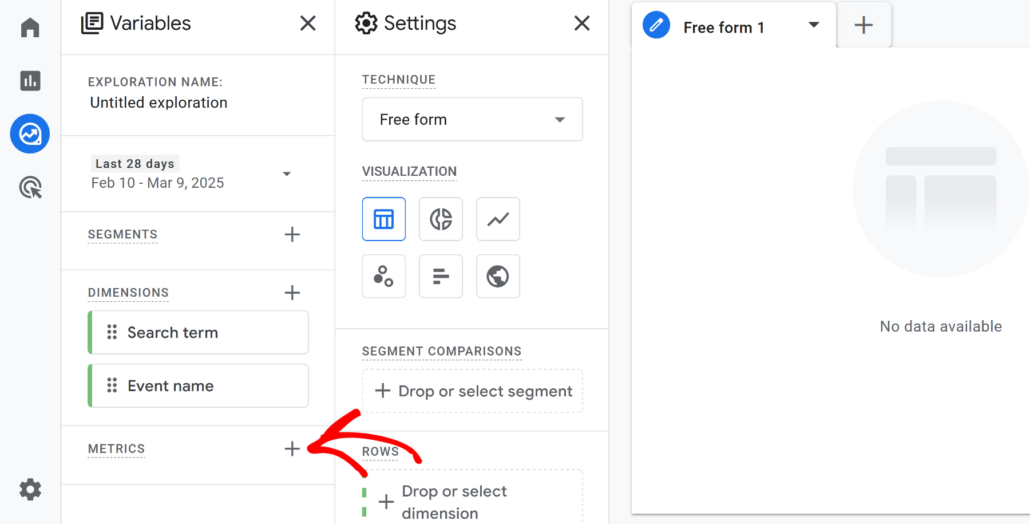
On the next screen, search for the Event count metric.
After that, you’ll need to click the ‘Confirm’ button at the top.
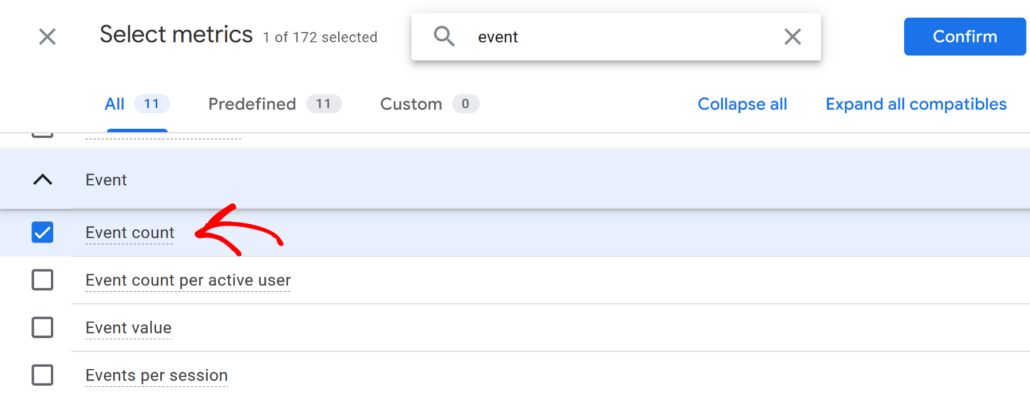
Next, you will need to drag the ‘Search term’ Dimension under the Rows box.
Once that’s done, drag the ‘Event count’ Metric down to the Values box.
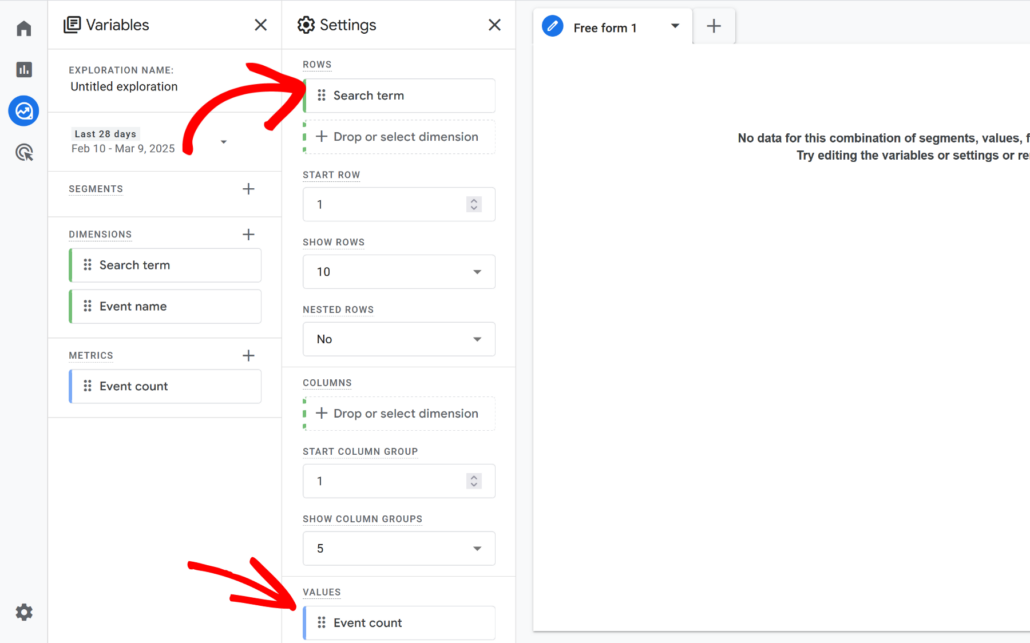
Lastly, you’ll need to drag the ‘Event name’ Dimension to the Filter box.
After that, you can set the conditions to exactly matches and view_search_results.
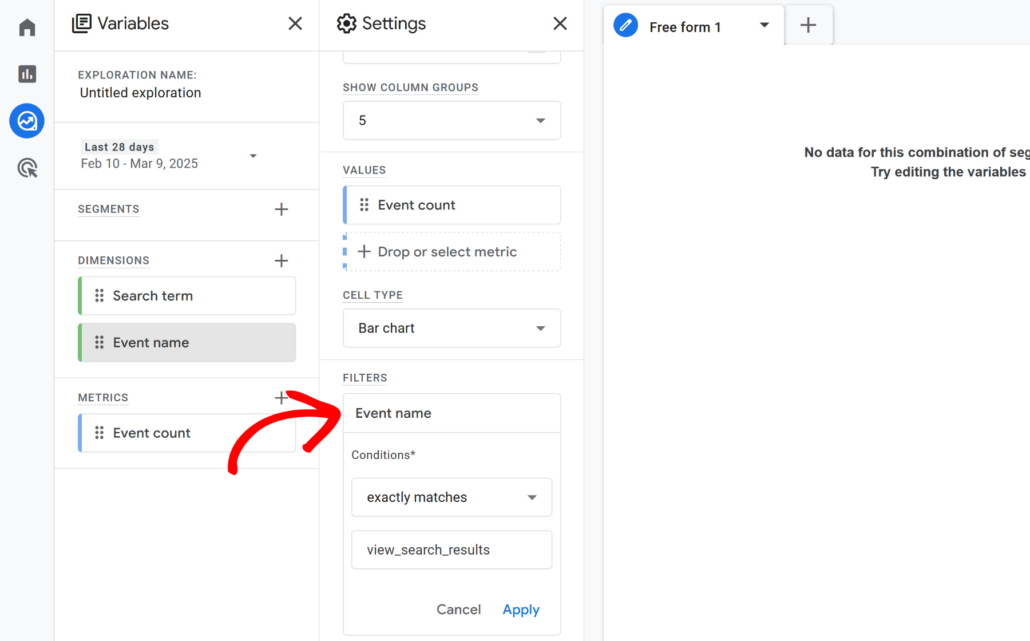
When that’s done, go ahead and click the ‘Apply’ button.
Your custom report for site searches in Google Analytics is now ready. When your visitors search anything on your site, it will be recorded in this report.
For example, here’s a report we created for our demo site. In the report, you’ll see the search terms and how many times each one was searched.
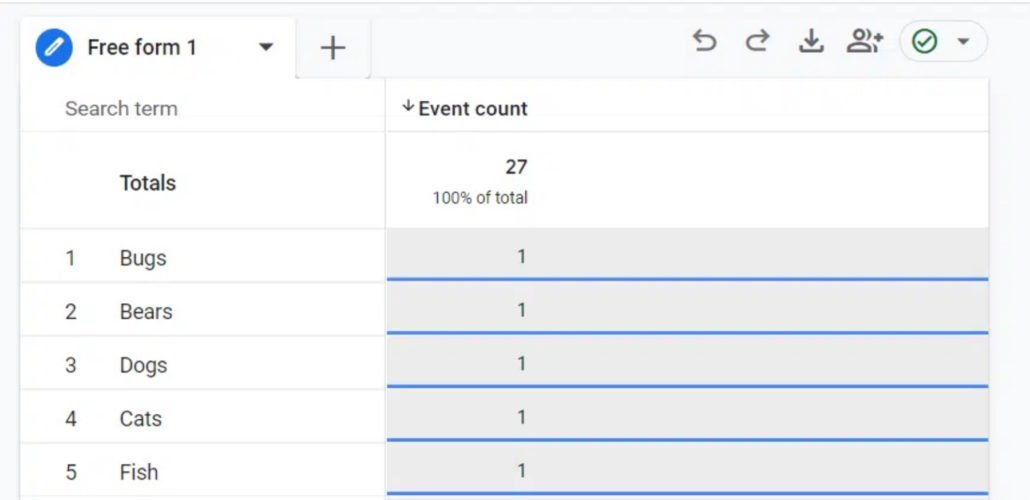
What’s Next…
That’s it, we’ve covered 2 simple methods for tracking searches in your WordPress site.
SearchWP is the best search plugin for WordPress and helps you view top searches in the admin panel. Plus, it offers a powerful Metrics extension that offers additional insights.
On the other hand, if you’re using Google Analytics and want to see what people are searching in your site, then MonsterInsights is the best solution.
We hope this article helped you learn how to track searches in WordPress. You may also want to see our guides on how to restrict WooCommerce product search to title only and how to add WordPress search by category.
If you’re ready to start tracking search queries on your site and prefer the first method, then grab your copy of SearchWP today.
